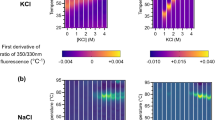Abstract
It is now clear that the understanding of halophilic adaptation at a molecular level requires a strategy of complementary experiments, combining molecular biology, biochemistry, and cellular approaches with physical chemistry and thermodynamics. In this review, after a discussion of the definition and composition of halophilic enzymes, the effects of salt on their activity, solubility, and stability are reviewed. We then describe how thermodynamic observations, such as parameters pertaining to solvent–protein interactions or enzyme-unfolding kinetics, depend strongly on solvent composition and reveal the important role played by water and ion binding to halophilic proteins. The three high-resolution crystal structures now available for halophilic proteins are analyzed in terms of haloadaptation, and finally cellular response to salt stress is discussed briefly.
Similar content being viewed by others
Author information
Authors and Affiliations
Additional information
Received: July 11, 1999 / Accepted: December 27, 1999
Rights and permissions
About this article
Cite this article
Madern, D., Ebel, C. & Zaccai, G. Halophilic adaptation of enzymes. Extremophiles 4, 91–98 (2000). https://doi.org/10.1007/s007920050142
Issue Date:
DOI: https://doi.org/10.1007/s007920050142




